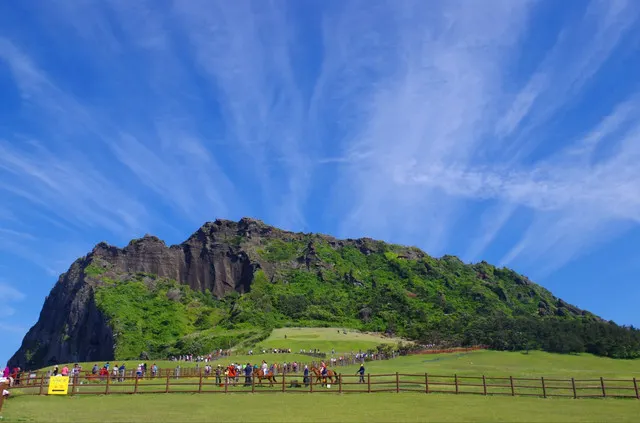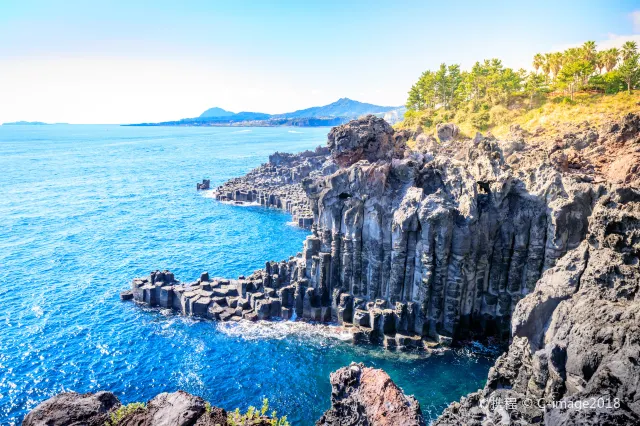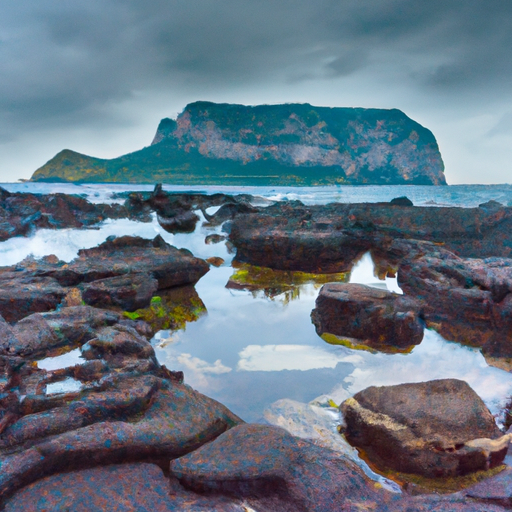Planning a trip to Jeju Island? Look no further! We’ve got you covered with a list of the top 10 must-see attractions on your Jeju Island adventure. From breathtaking waterfalls to stunning volcanic landscapes, there’s something for everyone on this beautiful South Korean island. Whether you’re interested in exploring unique natural wonders or learning about the island’s rich cultural heritage, our guide will ensure you make the most out of your trip. Get ready to immerse yourself in the beauty and charm of Jeju Island!
1. Jeju Folk Village Museum

1.1 Introduction to the museum
Welcome to the Jeju Folk Village Museum, a captivating destination that offers a glimpse into the rich cultural heritage of Jeju Island. As you step into the museum, you’ll be transported back in time to traditional Jeju village life. The museum aims to preserve and showcase the unique customs, architecture, and traditions that have shaped the island’s history.
1.2 Exhibits and displays
Immerse yourself in the fascinating exhibits and displays at the Jeju Folk Village Museum. From meticulously recreated thatched-roof houses and stone-walled enclosures, you’ll get a sense of the traditional Jeju village community. Explore the various themed areas, such as the farming village, fishing village, and noblemen’s village, each offering a distinct perspective of Jeju’s history and way of life.
1.3 Traditional performances
Experience the vibrancy and energy of traditional performances at the Jeju Folk Village Museum. Throughout the day, you’ll have the opportunity to witness cultural performances, including folk dances, music, and theater. Be captivated by the colorful costumes, rhythmic melodies, and graceful movements that showcase the artistic talents of the island’s inhabitants.
1.4 Gift shop and restaurants
Before leaving the museum, don’t forget to visit the gift shop and restaurants. Indulge in local delicacies and traditional Jeju cuisine at the on-site restaurants, offering a wide range of dishes made from fresh, local ingredients. The gift shop is the perfect place to find unique souvenirs and traditional crafts, allowing you to take a piece of Jeju’s cultural heritage home with you.
2. Mount Hallasan
2.1 Overview of Mount Hallasan
Standing proudly at the center of Jeju Island, Mount Hallasan is a majestic shield volcano and an iconic landmark. As the highest peak in South Korea, it offers breathtaking views and unparalleled natural beauty. Whether you’re an avid hiker or simply seeking tranquility in nature, a visit to Mount Hallasan is a must.
2.2 Hiking trails
Explore the diverse hiking trails that crisscross Mount Hallasan, catering to different levels of difficulty and hiking experience. From leisurely strolls to challenging ascents, there’s something for everyone. The trails wind through lush forests, spanning a variety of ecosystems, including alpine vegetation and rare flora unique to Jeju Island.

2.3 Ecological importance
Mount Hallasan is not only visually stunning but also a vital ecological hotspot. It is home to numerous plant and animal species, some of which are endemic to the island. As you hike through the mountain, keep an eye out for the diverse wildlife, including rare birds and butterflies. The mountain’s conservation efforts play a crucial role in preserving Jeju’s delicate ecosystem.
2.4 Wildlife and flora
The rich biodiversity of Mount Hallasan makes it a haven for nature lovers and enthusiasts. The mountain is known for its dense forests of Korean firs, maples, and oak trees. During different seasons, the landscape transforms, showcasing vibrant colors and providing a picturesque backdrop. From the lush vegetation to the chirping of birds, every step on Mount Hallasan is a sensory delight.
3. Jeongbang Waterfall
3.1 Natural beauty of Jeongbang Waterfall
Prepare to be enchanted by the natural beauty of Jeongbang Waterfall. This majestic waterfall cascades from a height of 23 meters, making it one of the most impressive waterfalls on Jeju Island. The sight and sound of the rushing water against the rocky cliffs create a mesmerizing and invigorating experience that will leave you in awe.
3.2 Accessibility and facilities
Jeongbang Waterfall is easily accessible, making it a popular destination for visitors. The well-maintained pathways and observation decks ensure a safe and enjoyable experience for all. The surrounding area is equipped with facilities such as restrooms and picnic areas, providing convenience and comfort during your visit.
3.3 Swimming and leisure activities
If you’re feeling adventurous, take a dip in the pool at the base of Jeongbang Waterfall. Swimming in the refreshing waters amidst the natural surroundings is a unique and exhilarating experience. However, please note that swimming may be prohibited during certain times or conditions for safety reasons.
3.4 Local myths and legends
Jeongbang Waterfall is steeped in local myths and legends that add to its allure. According to lore, the waterfall was once the bathhouse of the Dragon King, who came down from the heavens to take a bath. The legend adds a touch of mystique to the already captivating beauty of this natural wonder.
4. Seongsan Ilchulbong Peak

4.1 Formation and geological significance
One of Jeju Island’s most iconic landmarks, Seongsan Ilchulbong Peak, also known as the Sunrise Peak, is a dramatic volcanic cone shaped like a gigantic ancient castle. The peak was formed over 5,000 years ago through a series of volcanic eruptions and is a testament to the island’s volcanic history.
4.2 Sunrise and sunset views
A visit to Seongsan Ilchulbong Peak is incomplete without witnessing the breathtaking sunrise or sunset views. Hike up the steep but well-maintained trails early in the morning to catch the first rays of sunlight illuminating the landscape. Alternatively, visit in the evening to witness the fiery orange hues of the setting sun casting a warm glow over the surrounding area.
4.3 Visitor center and amenities
At the base of Seongsan Ilchulbong Peak, you’ll find a visitor center that provides information about the formation of the peak and its geological significance. The center also offers amenities such as restrooms, cafes, and souvenir shops where you can purchase mementos of your visit.
4.4 Hiking and trekking routes
For the adventurous souls, Seongsan Ilchulbong Peak offers various hiking and trekking routes that allow you to explore the area beyond the peak itself. These trails take you through lush forests, ancient volcanic landscapes, and panoramic viewpoints, providing a deeper appreciation of the unique geological wonders of Jeju Island.
5. Manjanggul Cave
5.1 Exploration of ancient lava tube
Manjanggul Cave is a UNESCO World Heritage site and one of the most remarkable lava tubes in the world. Step into this underground marvel and embark on a journey through time. The cave stretches for over 8 kilometers, offering an immersive experience into the geological history of Jeju Island.
5.2 Unique geological features
As you explore Manjanggul Cave, you’ll encounter a myriad of unique geological features. Marvel at the vast columns of solidified lava, known as lava stalactites and lava stalagmites, which form intricate patterns and shapes. This natural artwork is a testament to the power and beauty of volcanic activity.

5.3 Stalactites and lava formations
Manjanggul Cave is also home to the largest known lava column in the world, which stands magnificently at a height of 7.6 meters. The cave’s intricate network of tunnels and chambers, adorned with stalactites and lava formations, creates a captivating spectacle that showcases the sheer beauty of nature’s craftsmanship.
5.4 Conservation and preservation efforts
To ensure the preservation of Manjanggul Cave, certain sections are closed off to visitors. This helps protect the fragile ecosystem within the cave and allows ongoing research and conservation efforts to take place. By respecting the guidelines and regulations set forth, visitors can play their part in preserving this geological wonder for future generations to enjoy.
6. Loveland
6.1 Concept and purpose of Loveland
Loveland is a unique and unconventional attraction on Jeju Island that celebrates love, romance, and human sexuality through art. The park was created with the intention of providing adults a space to openly explore and embrace their sensual side, while also promoting a healthy and positive perspective on love and relationships.
6.2 Erotic art and sculptures
At Loveland, you’ll encounter an extensive collection of erotic art and sculptures, each conveying different aspects of love and desire. From playful and humorous depictions to more abstract and thought-provoking pieces, the art at Loveland aims to spark conversations and challenge societal taboos surrounding the expression of sexuality.
6.3 Romantic and adventurous experiences
Aside from the fascinating art, Loveland offers unique experiences for couples and individuals alike. Explore the park’s lush gardens hand-in-hand with your partner, capturing unforgettable memories against the backdrop of provocative sculptures. Engage in activities such as couple-themed workshops or sensual photo sessions, designed to enhance intimacy and create memorable moments.
6.4 Controversies and cultural perspectives
It is important to note that Loveland’s concept and exhibitions may evoke different reactions and opinions among visitors, depending on their cultural backgrounds and personal beliefs. While the park aims to foster open dialogues about sexuality and love, it is essential to approach the experience with an open mind and respect for diverse perspectives.
7. The Jeju Teddy Bear Museum

7.1 History and establishment
The Jeju Teddy Bear Museum is a delightful attraction that showcases the charming world of teddy bears. It offers a journey through the history of teddy bears, starting from their creation in the early 20th century to their role as beloved companions in modern times. The museum is a tribute to the enduring popularity and universal appeal of these cuddly toys.
7.2 Teddy bear collections and themes
As you explore the Jeju Teddy Bear Museum, you’ll encounter an extensive collection of teddy bears from different eras and countries. From antique bears with intricate craftsmanship to contemporary bears inspired by pop culture, each exhibit tells a unique story. Themes such as fairy tales, historical events, and famous personalities add an extra layer of fascination to the exhibits.
7.3 Interactive exhibits and workshops
The museum offers interactive exhibits and workshops, allowing visitors to engage with the world of teddy bears on a more personal level. Participate in bear-making workshops to create your very own teddy bear, adding a touch of customization and sentimentality to your visit. These hands-on experiences offer a unique opportunity to connect with the art of bear-making.
7.4 Souvenir shop and cafe
Before leaving the museum, be sure to visit the souvenir shop and cafe. The shop offers a wide range of teddy bear-themed products, from plush bears and accessories to unique memorabilia. Indulge in teddy bear-inspired treats and beverages at the on-site cafe, creating a sweet and whimsical end to your visit.
8. Hallim Park
8.1 Overview of the botanical garden
Hallim Park is a sprawling oasis that showcases the natural wonders of Jeju Island. This vast park is home to various themed gardens, making it an excellent destination for nature lovers and avid horticultural enthusiasts. Explore the lush greenery, vibrant flowers, and unique plant species that thrive in the park’s impeccably manicured landscapes.
8.2 Themed gardens and attractions
Hallim Park boasts an impressive array of themed gardens that cater to different interests and preferences. Wander through the Korean Traditional Garden, featuring traditional architecture and beautiful courtyards. The Palm Tree Avenue offers a tropical paradise with its towering palm trees and exotic plants. Don’t miss the Bonsai Garden, where miniature masterpieces of old-age trees enchant visitors with their intricate beauty.
8.3 Stone and bonsai garden
One of the highlights of Hallim Park is the Stone and Bonsai Garden, where meticulously pruned bonsai trees and intricate stone sculptures captivate the imagination. Marvel at the artistry and precision required to create these miniature landscapes, which represent the harmony between nature and human creativity.
8.4 Walking trails and photo spots
Hallim Park invites visitors to explore its winding paths and discover hidden corners of natural beauty. Meander along walking trails that wind through forests, past ponds, and over quaint bridges. Along the way, you’ll encounter numerous photo spots, offering picturesque backdrops for capturing memorable moments amidst the park’s stunning scenery.
9. O’Sulloc Tea Museum
9.1 History and significance of tea in Jeju
Discover the rich history and cultural significance of tea in Jeju at the O’Sulloc Tea Museum. Jeju Island has a long tradition of tea cultivation, and the museum pays homage to this ancient art form. Immerse yourself in the world of tea, from its cultivation and processing to traditional tea ceremonies and tastings.
9.2 Tea cultivation and processing
Learn about the intricate process of tea cultivation and processing, which includes harvesting the tea leaves, drying, and rolling them to bring out the distinct flavors and aromas. The museum offers insightful displays and exhibits that showcase the different techniques and methods used throughout history, highlighting the craftsmanship and dedication behind a perfect cup of tea.
9.3 Traditional tea ceremonies and tastings
Partake in traditional tea ceremonies guided by experts who will enlighten you about the art and philosophy of tea in Jeju. Experience the serene ambiance and ritualistic nature of tea ceremonies as you savor the delicate flavors of Jeju tea. Don’t miss the opportunity to taste a variety of tea blends, ranging from classic green teas to unique Jeju specialty teas.
9.4 Tea house and tea-related products
Before leaving the museum, take a moment to relax at the on-site tea house, where you can indulge in a cup of freshly brewed tea accompanied by traditional Korean snacks. The museum’s tea house offers a tranquil setting to reflect on your tea journey and the cultural significance of tea. Browse through the tea-related products in the museum’s gift shop, including tea sets, teapots, and souvenir teas to continue your tea appreciation at home.
10. Jeju Haenyeo Museum
10.1 Introduction to Jeju’s female divers
The Jeju Haenyeo Museum showcases the unique culture and way of life of the Haenyeo, Jeju’s renowned female divers. For centuries, these strong and resilient women have ventured into the treacherous waters to harvest seafood without the use of modern diving equipment. The museum pays tribute to their bravery and the vital role they play in Jeju’s coastal communities.
10.2 History and cultural heritage
Learn about the history and cultural heritage of the Haenyeo, dating back to the 17th century. The museum presents fascinating exhibits and artifacts that depict the daily lives, challenges, and traditions of these remarkable women. Gain insight into their techniques, tools, and the bond they share as a community of divers.
10.3 Life and traditions of Haenyeo
Through interactive displays and multimedia presentations, the Jeju Haenyeo Museum offers a glimpse into the lives of the Haenyeo. Learn about their rigorous training, harvesting methods, and the challenges they face in the face of changing environmental conditions. Gain a deeper understanding of the close relationship between the Haenyeo and the sea, and their deep-rooted respect for nature.
10.4 Educational programs and exhibits
The museum hosts educational programs and workshops that allow visitors to engage with the Haenyeo culture on a more personal level. Participate in hands-on activities such as diving simulations, traditional fishing techniques, or crafting workshops to gain a deeper appreciation for the Haenyeo way of life. The exhibits provide a comprehensive overview of the Haenyeo’s cultural significance and their impact on Jeju’s identity as a coastal community.
With these ten must-see attractions, your Jeju Island trip promises to be a journey of discovery, from the rich cultural heritage preserved at the Jeju Folk Village Museum to the awe-inspiring natural wonders found at Mount Hallasan. Embrace the island’s unique charm and immerse yourself in the diverse experiences that await you on this enchanting Korean island.

